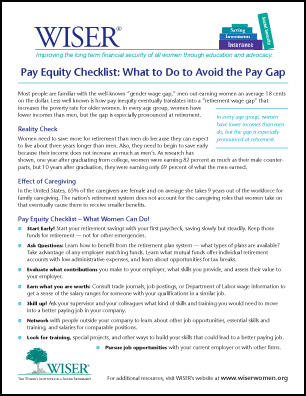Most people are familiar with the well-known “gender wage gap,” men out-earning women an average 18 cents on the dollar. Less well known is  how pay inequity eventually translates into a “retirement wage gap” that increases the poverty rate for older women. In every age group, women have lower incomes than men, but the gap is especially pronounced at retirement.
how pay inequity eventually translates into a “retirement wage gap” that increases the poverty rate for older women. In every age group, women have lower incomes than men, but the gap is especially pronounced at retirement.
Reality Check
Women need to save more for retirement than men do because they can expect to live about three years longer than men. Also, they need to begin to save early because their income does not increase as much as men’s. As research has shown, one year after graduating from college, women were earning 82 percent as much as their male counter-parts, but 10 years after graduation, they were earning only 69 percent of what the men earned.
Effect of Caregiving
In the United States, 65% of the caregivers are female and on average she takes 9 years out of the workforce for family caregiving. The nation’s retirement system does not account for the caregiving roles that women take on that eventually cause them to receive smaller benefits.
Pay Equity Checklist – What Women Can Do!
- Start Early! Start your retirement savings with your first paycheck, saving slowly but steadily. Keep those funds for retirement — not for other emergencies.
- Ask Questions: Learn how to benefit from the retirement plan system — what types of plans are available? Take advantage of any employer matching funds. Learn what mutual funds offer individual retirement accounts with low administrative expenses, and learn about opportunities for tax breaks.
- Evaluate what contributions you make to your employer, what skills you provide, and assess their value to your employer.
- Learn what you are worth: Consult trade journals, job postings, or Department of Labor wage information to get a sense of the salary ranges for someone with your qualifications in a similar job.
- Skill up! Ask your supervisor and your colleagues what kind of skills and training you would need to move into a better paying job in your company.
- Network with people outside your company to learn about other job opportunities, essential skills and training, and salaries for comparable positions.
- Look for training, special projects, and other ways to build your skills that could lead to a better paying job.
- Pursue job opportunities with your current employer or with other firms.
Also check out WISER’s Factsheet, “and…The Pay Gap’s Connected to the Retirement Gap!“

